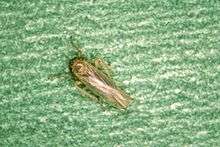Macrosteles quadrilineatus
| Macrosteles quadrilineatus | |
|---|---|
 | |
| Aster leafhopper | |
| Scientific classification | |
| Kingdom: | Animalia |
| Phylum: | Arthropoda |
| Class: | Insecta |
| Order: | Hemiptera |
| Suborder: | Auchenorrhyncha |
| Superfamily: | Cicadoidea |
| Family: | Cicadellidae |
| Subfamily: | Deltocephalinae |
| Tribe: | Macrostelini |
| Genus: | Macrosteles |
| Species: | M. quadrilineatus |
| Binomial name | |
| Macrosteles quadrilineatus Forbes 1885 | |
Macrosteles quadrilineatus, the aster leafhopper or six-spotted leafhopper, is a leafhopper species in the genus Macrosteles, found in the United States. It is the vector of aster yellows disease, which affects various vegetable plants, weeds and ornamental plants.
Description
The aster leafhopper is a small species, with males reaching about 3.3 mm (0.13 in) in length and females about 3.7 mm (0.15 in). The fore-wings are greyish-green while the abdomen is yellowish-green. Six pairs of minute black spots or streaks on the head give the insect its alternative name of six-spotted leafhopper.[1]
Ecology
In the United States, strong southerly winds in the spring carry adults northwards to the Mid West and northern parts of the country, and these insects usually arrive earlier and exceed in number the resident insects that have been overwintering there, mostly on grasses and cereals. Eggs are laid on a wide range of host plants which include grasses and clovers, corn, oats, rye, carrots and various weeds. The eggs hatch in about one week and the whole life cycle takes about four weeks. Carrot, dill, potato and radish are selected by adults for feeding purposes but are not good for breeding purposes.[1]
The leafhopper is attacked by several parasitoids including Pachygonatopus minimus,[2] Neogonatopus ombrodes[1] and Epigonatopus plesius.[3]
Aster yellows
Aster yellows is a disease of various vegetable crops, weeds and ornamental plants[4] and is transmitted almost entirely by the aster leafhopper.[1] The disease is caused by phytoplasmas, specialised bacteria that are obligate parasites of plant tissue. The symptoms shown by the plant are a yellowing of the leaf veins followed by yellowing of the leaf blades, spindly stems with pale leaves, stunting of the plant, and deformed flowers, which sometimes show green colouring.[4] Vegetable crops affected include carrot, celery, lettuce, potato, cucumber, pumpkin and squash.[1]
References
- 1 2 3 4 5 Capinera, John L. (2001). Handbook of Vegetable Pests. Gulf Professional Publishing. pp. 330–333. ISBN 978-0-12-158861-8.
- ↑ Barrett, C. F.; Westdal, P. H.; Richardson, H. P. (1965). "Biology of Pachygonatopus minimus Fenton (Hymenoptera: Dryinidae) a Parasite of the Six-spotted Leafhopper, Macrosteles fascifrons (Stål), in Manitoba". The Canadian Entomologist. 97 (2): 216–221. doi:10.4039/Ent97216-2.
- ↑ George, J. A. (1959). "Note on Epigonatopus plesius (Fenton) (Hymenoptera: Dryinidae), a Parasite of the Six-Spotted Leafhopper, Macrosteles fascifrons (Stal), in Ontario". The Canadian Entomologist. 91 (4): 216–221. doi:10.4039/Ent91256-4.
- 1 2 Schrock, Denny (2004). Ortho Home Gardener's Problem Solver. Meredith Books. p. 128. ISBN 978-0-89721-504-6.
External links
- Macrosteles quadrilineatus at bugguide.net